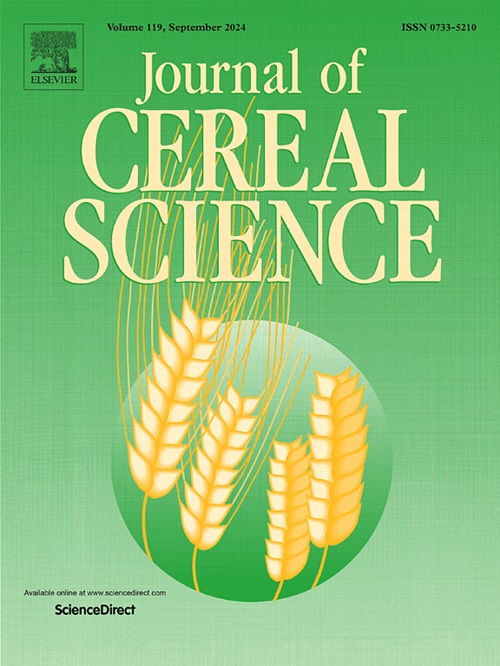发芽对藜麦(Chenopodium quinoa var. Blanca de Junin)和玉米(Zea mays -优质蛋白玉米)面粉流变特性的影响及其在无麸质配方中的应用
IF 3.9
2区 农林科学
Q2 FOOD SCIENCE & TECHNOLOGY
引用次数: 0
摘要
本研究对发芽藜麦和玉米粉的理化、粘弹性和糊化特性及其在无麸质食品中的应用进行了评价。将黄玉米(Zea mays - Quality Protein maize)和白藜麦(Chenopodium quinoa var. Blanca de Junin)分别加工成粒径为A (<500 μm)、B (106 - 500 μm)和C (<106 μm)的未发芽(NQ)和发芽(GQ)藜麦粉以及未发芽(NM)和发芽(GM)玉米粉。基于近似分析数据、糊化热参数、糊化性能和扫描频率,确定了最佳的面粉处理方法。选择粒径为106 ~ 500 μm (GQB)的发芽藜麦粉和粒径为106 μm (GMC)的发芽玉米粉,因为它们具有与小麦相当的优越比体积和流变性能。对不同的藜麦、玉米和水的混合物进行了测试,以制备无麸质面包和蛋糕。面包(20%藜麦,20%玉米,60%水)和蛋糕(45%藜麦,45%玉米,10%水)配方表现出最佳的质地和感官特性。与用玉米粉制作的烘焙食品相比,用发芽藜麦面粉制作的烘焙食品显示出更强的功能和流变特性,尽管混合这两种面粉可以提高无麸质食品的可接受性和质地特性。本文章由计算机程序翻译,如有差异,请以英文原文为准。

Effect of germination on the rheological properties of quinoa (Chenopodium quinoa var. Blanca de Junin) and maize (Zea mays - Quality Protein Maize) flours and application in gluten-free formulations
The physicochemical, viscoelastic, and pasting properties of germinated quinoa and maize flours, as well as their application in gluten-free products, were evaluated in this study. Yellow maize (Zea mays - Quality Protein Maize) and white quinoa (Chenopodium quinoa var. Blanca de Junin) were processed into non-germinated (NQ) and germinated (GQ) quinoa flours and non-germinated (NM) and germinated (GM) maize flours with A (<500 μm), B (106–500 μm), and C (<106 μm) particle sizes. Based on proximate analysis data, gelatinization thermal parameters, pasting properties, and frequency sweeps, the best flour treatments were identified. Germinated quinoa flour with a particle size of 106–500 μm (GQB) and germinated maize flour with a particle size <106 μm (GMC) were selected due to their superior specific volume and rheological properties comparable to wheat. Different quinoa, maize, and water mixtures were tested for the preparation of gluten-free bread and cake. Bread (20% quinoa, 20% maize, and 60% water) and cake (45% quinoa, 45% maize, and 10% water) formulations were found to exhibit the best textural and sensory characteristics. Baked goods made from germinated quinoa flours showed enhanced functional and rheological characteristics compared to those prepared with maize flours, although blending both flours improved acceptability and textural properties in gluten-free products.
求助全文
通过发布文献求助,成功后即可免费获取论文全文。
去求助
来源期刊

Journal of Cereal Science
工程技术-食品科技
CiteScore
7.80
自引率
2.60%
发文量
163
审稿时长
38 days
期刊介绍:
The Journal of Cereal Science was established in 1983 to provide an International forum for the publication of original research papers of high standing covering all aspects of cereal science related to the functional and nutritional quality of cereal grains (true cereals - members of the Poaceae family and starchy pseudocereals - members of the Amaranthaceae, Chenopodiaceae and Polygonaceae families) and their products, in relation to the cereals used. The journal also publishes concise and critical review articles appraising the status and future directions of specific areas of cereal science and short communications that present news of important advances in research. The journal aims at topicality and at providing comprehensive coverage of progress in the field.
 求助内容:
求助内容: 应助结果提醒方式:
应助结果提醒方式:


